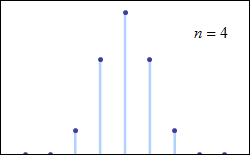De Moivre–Laplace theorem
De Moivre–Laplace theorem is a fundamental result in the field of probability theory and statistics that serves as a bridge between binomial distributions and the normal distribution. This theorem is named after Abraham de Moivre and Pierre-Simon Laplace, two prominent mathematicians who made significant contributions to probability theory and statistics.
Overview[edit | edit source]
The De Moivre–Laplace theorem is primarily concerned with the approximation of binomial distributions. It states that as the number of trials in a binomial experiment increases, the shape of the binomial distribution approaches that of a normal distribution. Specifically, if an experiment consists of n independent trials, each with a probability p of success and q = 1 - p of failure, then the binomial probability distribution of the number of successes can be approximated by the normal distribution, provided that n is sufficiently large.
Mathematical Formulation[edit | edit source]
Mathematically, the theorem can be expressed as follows: If X is a binomial random variable with parameters n and p, then the standardized variable
\[ Z = \frac{X - np}{\sqrt{npq}} \]
converges in distribution to a standard normal variable as n → ∞. Here, np is the mean of the binomial distribution, and \sqrt{npq} is its standard deviation.
Applications[edit | edit source]
The De Moivre–Laplace theorem is widely used in various fields, including statistics, engineering, economics, and social sciences, to approximate probabilities of outcomes in binomial settings. It is particularly useful in situations where calculating binomial probabilities directly is computationally intensive or impractical due to a large number of trials.
Historical Context[edit | edit source]
Abraham de Moivre, a French mathematician, initially discovered the theorem in the 18th century. He published his findings in his work "The Doctrine of Chances," where he provided a method to approximate binomial probabilities using the normal curve. Later, Pierre-Simon Laplace expanded on de Moivre's work, further establishing the connection between binomial and normal distributions. Their combined efforts laid the groundwork for the central limit theorem, a cornerstone of probability theory.
See Also[edit | edit source]
Search WikiMD
Ad.Tired of being Overweight? Try W8MD's physician weight loss program.
Semaglutide (Ozempic / Wegovy and Tirzepatide (Mounjaro / Zepbound) available.
Advertise on WikiMD
|
WikiMD's Wellness Encyclopedia |
| Let Food Be Thy Medicine Medicine Thy Food - Hippocrates |
Translate this page: - East Asian
中文,
日本,
한국어,
South Asian
हिन्दी,
தமிழ்,
తెలుగు,
Urdu,
ಕನ್ನಡ,
Southeast Asian
Indonesian,
Vietnamese,
Thai,
မြန်မာဘာသာ,
বাংলা
European
español,
Deutsch,
français,
Greek,
português do Brasil,
polski,
română,
русский,
Nederlands,
norsk,
svenska,
suomi,
Italian
Middle Eastern & African
عربى,
Turkish,
Persian,
Hebrew,
Afrikaans,
isiZulu,
Kiswahili,
Other
Bulgarian,
Hungarian,
Czech,
Swedish,
മലയാളം,
मराठी,
ਪੰਜਾਬੀ,
ગુજરાતી,
Portuguese,
Ukrainian
Medical Disclaimer: WikiMD is not a substitute for professional medical advice. The information on WikiMD is provided as an information resource only, may be incorrect, outdated or misleading, and is not to be used or relied on for any diagnostic or treatment purposes. Please consult your health care provider before making any healthcare decisions or for guidance about a specific medical condition. WikiMD expressly disclaims responsibility, and shall have no liability, for any damages, loss, injury, or liability whatsoever suffered as a result of your reliance on the information contained in this site. By visiting this site you agree to the foregoing terms and conditions, which may from time to time be changed or supplemented by WikiMD. If you do not agree to the foregoing terms and conditions, you should not enter or use this site. See full disclaimer.
Credits:Most images are courtesy of Wikimedia commons, and templates Wikipedia, licensed under CC BY SA or similar.
Contributors: Prab R. Tumpati, MD


